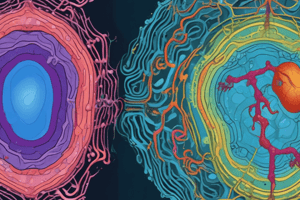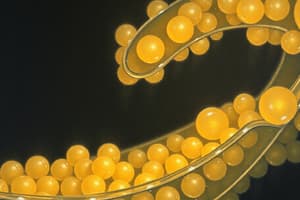Podcast
Questions and Answers
Match the aquaporin with its primary location in the body:
Match the aquaporin with its primary location in the body:
Aquaporin-1 (AQP1) = Kidney, liver, lung Aquaporin-2 (AQP2) = Kidneys Aquaporin-3 (AQP3) = Skin, lungs Aquaporin-4 (AQP4) = Brain, blood vessels
Match the aquaporin with its role in the body:
Match the aquaporin with its role in the body:
Aquaporin-2 (AQP2) = Urine concentration and dilution Aquaporin-4 (AQP4) = Regulation of cerebral edema Aquaporin-5 (AQP5) = Facilitation of fluid secretion in salivary and sweat glands Aquaporin-1 (AQP1) = Widespread distribution in many organs
Match the aquaporin with its specific function:
Match the aquaporin with its specific function:
Aquaporin-3 (AQP3) = Mainly localized in skin and lungs Aquaporin-5 (AQP5) = Secretion of fluid in salivary glands Aquaporin-1 (AQP1) = Most widespread human aquaporin Aquaporin-4 (AQP4) = Essential for regulating cerebral edema
Match the aquaporin regulation mechanism with the corresponding stimuli:
Match the aquaporin regulation mechanism with the corresponding stimuli:
Match the aquaporin with its presence in specific glands:
Match the aquaporin with its presence in specific glands:
Study Notes
Aquaporin Channels and Water Molecule Passage
The cell membrane is a selective barrier between the inside of a cell and its environment. It regulates the movement of various molecules into and out of the cell, while maintaining the homeostasis necessary for the cell's survival. One such process regulated by the cell membrane is the passage of water molecules across it. This passage occurs primarily through specialized proteins known as aquaporins, which form channels specifically designed for the rapid transport of water.
What Are Aquaporins?
Aquaporins are small proteins embedded within the cell membrane that facilitate the passive diffusion of water molecules across the membrane. They were first discovered in red blood cells and later found ubiquitously throughout animal tissues and other organisms. These proteins play a crucial role in processes like osmoregulation, cellular hydration, and waste removal.
Mechanism of Action
Aquaporins create a water conduit through the lipid bilayer, allowing water molecules to passively move from regions of higher concentration to lower concentration without the need for energy input. Each individual channel can accommodate several hundred water molecules per second, enabling efficient water transport. The speed with which these proteins allow water to flow through is impressive; they have been estimated to act as fast as one million times faster than the simple diffusion rate for water.
Types of Aquaporins
There are several types of aquaporins that differ in their biophysical properties and function:
- Aquaporin-1 (AQP1): Found in many organs, including the kidney, liver, and lung, AQP1 is the most widespread human aquaporin.
- Aquaporin-2 (AQP2): Primarily expressed in the kidneys, AQP2 plays a significant role in urine concentration and dilution.
- Aquaporin-3 (AQP3): Localized mainly in the skin and lungs, AQP3 has also been identified in some epithelial cells throughout the body.
- Aquaporin-4 (AQP4): Expressed in both astrocytes in the brain and endothelial cells in blood vessels, AQP4 is essential for the regulation of cerebral edema.
- Aquaporin-5 (AQP5): Located mostly in salivary glands and sweat glands, AQP5 facilitates the secretion of fluid in these organs.
These distinct aquaporins serve different functions based on their specific locations and roles in the body.
Regulation of Aquaporin Function
Aquaporins are highly regulated proteins that respond to various physiological stimuli and signals. For example, they can be modulated by hormonal signaling pathways, changes in temperature, and osmotic stress. Additionally, some aquaporins may be regulated post-transcriptionally by phosphorylation events on key residues within the protein sequence.
In summary, aquaporins are integral parts of the cell membrane that allow for the swift and controlled passage of water molecules. Their presence enables cells to maintain proper hydration levels and perform critical biological functions requiring water translocation.
Studying That Suits You
Use AI to generate personalized quizzes and flashcards to suit your learning preferences.
Description
Learn about aquaporins, the specialized proteins that facilitate the passage of water molecules across cell membranes. Explore the types, mechanisms of action, and regulation of aquaporins in cellular hydration and homeostasis.




